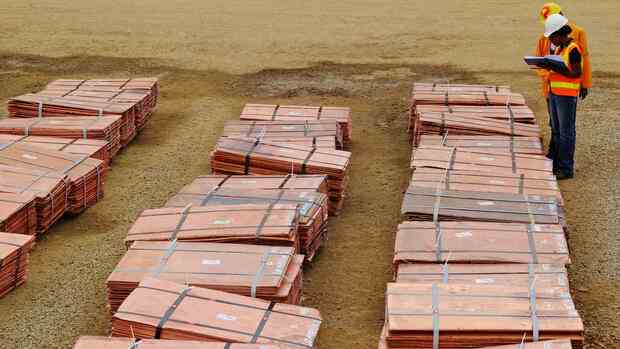Zurich According to Glencore CEO Gary Nagle, the world is heading towards a massive copper shortage. This endangers the goal of the world community to limit global warming to 1.5 percent. “There’s a copper deficit coming – but the world doesn’t seem to understand that,” Nagle warned at a presentation to shareholders on Tuesday. With a production of around one million tons of copper per year, Glencore is one of the world’s largest producers.
According to Nagle, copper demand threatens to exceed available supply by 50 million tons in 2030. “This is equivalent to a two-year shutdown of global copper production,” he says. The reason for the rapidly increasing demand for copper is the expansion of renewable energies necessary for the climate goals and the electrification of mobility.
Glencore refers to the International Energy Agency (IEA) for the model calculations. Accordingly, copper demand for the construction of wind turbines, solar systems, battery storage and new power grids will increase by 100 million tons by 2030. Another 20 million tons will be added for the expansion of electromobility. Overall, global copper demand is likely to level off at around 350 million tons. On the other hand, there is a forecast supply of around 300 million tons.
The goal of removing as much carbon dioxide from the atmosphere as is produced by 2050 is in serious jeopardy due to the lack of copper, warns Glencore boss Nagle.
Top jobs of the day
Find the best jobs now and
be notified by email.
More funding? “Only when the market is screaming for copper”
Despite the foreseeable large excess demand, Glencore is only slowly expanding its own copper production. It is true that production could be increased by up to 60 percent by expanding existing mines. Glencore operates large mines with expansion potential in countries such as Congo, Peru and Chile. For the time being, however, the commodity giant is not planning to increase copper production in the next three years.
“It’s not until the market is crying out for copper and prices are a few dollars from destroying demand that that’s when we bring additional copper supply to the market.”
(Photo: Glencore/Twitter)
Nagle underscored that Glencore wants to see prices rise first before raising production. “We will not rush to expand production,” Nagle said. “It’s not until the market is screaming for copper and prices are a few dollars from destroying demand that that’s when we bring additional copper supply to the market.”
>> Read about this: How Western industries can make themselves less dependent on raw material imports
The copper price is currently quoted at around 8400 dollars per ton. Glencore CEO Nagle made little secret of the fact that a long-term high copper price is needed before new mining projects could be developed. Glencore has secured access to an undevelopable mine in Argentina.
At the same time, the raw materials group wants to expand its dominant position in other metals required for the energy transition. The group is the world’s largest producer of cobalt, which is also used in batteries for electric cars. The group is also investing heavily in the recycling of scrap metal.
Multi-billion profits – also with coal
Although Nagle wants to position the company as a supplier of the raw materials for the energy transition, he is also sticking to the company’s coal production. By 2025, Glencore wants to produce 110 million tons of coal every year. As a native South African, who for a long time managed the coal business of the Swiss commodity giant, Nagle knows exactly how dependent developing countries in particular are on fossil fuels. The aim is to secure the energy supply today and tomorrow. “We occupy this niche.” At the same time, he will maximize returns for shareholders.
For the coming year, Nagle forecast earnings before taxes (Ebitda) of $28.7 billion and free cash flow of $14.5 billion. This corresponds to a significant increase compared to the record year 2021. Last year Glencore still generated a pre-tax profit of $21.3 billion and free cash flow of $16.7 billion.
>> Also read: ‘Bribery was part of the culture’ – Glencore fined £280m
This prospect also convinces the analysts: The US bank Jefferies issued a study on Tuesday recommending buying Glencore shares. The bank’s analysts gave the price target of 700 pence, which corresponds to an upside potential of 27 percent.
However, Nagle’s course is controversial among shareholders: At the annual general meeting in April, more than 20 percent of shareholders voted against the company’s climate plan, which provides for a gradual reduction in coal production with stable production over the next three years. A small group of activist investors are calling for the coal business to be split off. However, Nagle resisted this until the very end.
More: Commodity market stress – slump in prices shows fear of recession
